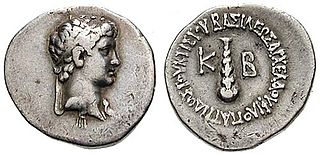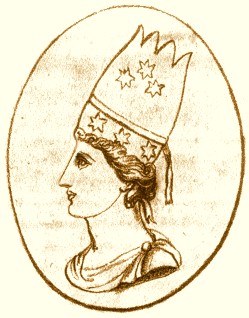Related Research Articles
This article concerns the period 39 BC – 30 BC.

Alexander Helios was a Ptolemaic prince and son of Pharaoh Cleopatra VII of the Ptolemaic dynasty and Roman triumvir Mark Antony. Alexander's fraternal twin sister was Cleopatra Selene II. Cleopatra named her son after Alexander the Great. His second name in Ancient Greek means "Sun"; this was the counterpart of his twin sister's second name Selene (Σελήνη), meaning "Moon".
Iotapa may refer to:

Phraates IV was King of Kings of the Parthian Empire from 37 to 2 BC. He was the son and successor of Orodes II, and was given the throne after the death of his brother Pacorus I. Phraates IV soon murdered all his brothers, and also possibly his father. His actions alienated the Armenians and also some of his nobles, including the distinguished Monaeses, who fled to the Roman triumvir Mark Antony, but shortly returned and reconciled with Phraates IV.

Artavasdes II, also known as Artavazd II, was king of Armenia from 55 BC to 34 BC. A member of the Artaxiad dynasty, he was the son and successor of Tigranes the Great, who ascended the throne of a still powerful and independent state. His mother was Cleopatra of Pontus, thus making his maternal grandfather the prominent King of Pontus Mithridates VI Eupator. Like his father, Artavasdes continued using the title of King of Kings, as seen from his coins.
Polemon I Pythodoros was the Roman Client King of Cilicia, Pontus, Colchis and the Bosporan Kingdom. Polemon was the son and heir of Zenon and possibly Tryphaena. Zenon and Polemon adorned Laodicea with many dedicated offerings.

Archelaus was a Roman client prince and the last king of Cappadocia. He was also husband of Pythodorida, Queen regnant of Pontus.
Cleopatra of Pontus was a Pontian princess and a queen consort of Armenia.

Erato was a queen of Armenia from the Artaxiad dynasty. She co-ruled as Roman client queen in 8–5 BC and 2 BC–AD 1 with Tigranes IV. Erato reigned alone in 1–2 AD. After living in political exile for a number of years, she co-ruled as Roman client queen from 6 until 12 with Tigranes V, her distant paternal relative and possible second husband. She may be viewed as one of the last hereditary rulers of her nation.

Artavasdes IV of Armenia; also known as Artavasdes II of Atropatene; Artavasdes II of Media Atropatene and Armenia Major; Artavasdes II, and Artavasdes was an Iranian prince who served as King of Media Atropatene. During his reign of Media Atropatene, Artavasdes also served as a Roman Client King of Armenia Major.
Mithridates III Antiochus Epiphanes was a prince who served as a King of Commagene.

Antony's Atropatene campaign, also known as Antony's Parthian campaign, was a military campaign by Mark Antony, the eastern triumvir of the Roman Republic, against the Parthian Empire under Phraates IV.

Artavasdes I of Media Atropatene, also known as Artavasdes I of Atropatene and Artabazus, was a prince who served as a king of Media Atropatene. Artavasdes I was an enemy of King Artavasdes II of Armenia and his son Artaxias II. He was a contemporary with the Ptolemaic Greek Queen Cleopatra VII and Roman Triumvir Mark Antony, as Artavasdes I was mentioned in their diplomatic affairs.
Youtab meaning "unique" in Old Persian was an ancient Persian noblewoman.
Artavasdes is the Hellenized form of the Iranian name *R̥tavazdāʰ. Variant renderings in Greek include Artabazos (Ἀρτάβαζος), Artabazes (Ἀρταβάζης), and Artabasdos (Ἀρτάβασδος); in Armenian Artavazd (Արտավազդ); and in Latin Ardabastus or Artabasdus. Artavasdes' name is the Latin attestation of an Old Iranian name *Ṛtavazdah-, identical to the Avestan Ašavazdah, presumably meaning "powerful/persevering through truth"
Ariobarzanes I of Media Atropatene, also known as Ariobarzanes I of Media, Ariobarzanes of Atropatene, Ariobarzanes I and Ariobarzanes was king of Media Atropatene.

Asinnalus of Media Atropatene was a Prince who served as a King of Media Atropatene.
Ariobarzanes II of Atropatene also known as Ariobarzanes of Media; Ariobarzanes of Armenia; Ariobarzanes II; Ariobarzanes II of Media Atropatene and Ariobarzanes was king of Media Atropatene who ruled sometime from 28 BC to 20 BC until 4 and was appointed by the Roman emperor Augustus to serve as a Roman client king of Armenia from 2 AD until 4.
Iotapa was a princess of Commagene, daughter of King Mithridates III of Commagene. She became the Queen consort of Syrian King Sampsiceramus II of Emesa.
Julia Iotapa or Julia Iotape, sometimes known as Julia of Cilicia, was a Cilician princess who lived in the 1st century and 2nd century. Daughter of King Gaius Julius Alexander of Cetis, she married Gaius Julius Quadratus Bassus, Galatian Roman Senator from Anatolia.